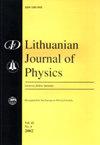Microwave electromagnetic shielding effectiveness of ZnNb2O6-chopped strands composites for radar and wideband (6.5–18 GHz) applications
IF 0.3
4区 物理与天体物理
Q4 PHYSICS, MULTIDISCIPLINARY
引用次数: 3
Abstract
In this study, the traditional mixed oxide process was used to create ZnNb2O6-chopped strands composites. The single phase compound with the chemical formula ZnNb2O6 was generated after sintering at 1100°C for 4 h. For the structural investigation, various quantities of ZnNb2O6-chopped strands were generated. X-ray diffraction (XRD), scanning electron microscopy (SEM) and energy-dispersive X-ray spectroscopy (EDS) were carried out for the structural analysis, which indicated that the second phase did not form in ZnNb2O6. Additionally, the ZnNb2O6-strands composites were manufactured by hot pressing using the compositions of ZnNb2O6-chopped strands in various proportions and epoxy. The ZnNb2O6-chopped strands compound formed in various weights, and epoxy resin were used to fabricate microwave shielding effectiveness composites. Utilizing a network analyzer, the microwave shielding effect of ZnNb2O6-chopped strands composites was investigated in a range of 6.5–18 GHz. At a thickness of 1.5 mm, a minimum of –51.32 dB shielding effectiveness value was achieved at 6.75 GHz. The ZnNb2O6-chopped strands compounds were produced as composite and their features were characterized for shielding effectivacy. The content of components in the samples may be managed for the larger and needed frequency bands to change the microwave shielding performance.znnb2o6 -切碎链复合材料在雷达和宽带(6.5-18 GHz)应用中的微波电磁屏蔽效果
在本研究中,采用传统的混合氧化物工艺制备了ZnNb2O6短切股复合材料。化学式为ZnNb2O6的单相化合物是在1100°C下烧结4小时后产生的。为了进行结构研究,产生了不同数量的ZnNb2O 6短切股。通过X射线衍射(XRD)、扫描电子显微镜(SEM)和能谱仪(EDS)进行了结构分析,表明ZnNb2O6中没有形成第二相。此外,使用不同比例的ZnNb2O6短切股线和环氧树脂的组合物,通过热压制备了ZnNb2O5股线复合材料。采用不同重量的ZnNb2O6短切复合材料和环氧树脂制备了微波屏蔽效能复合材料。利用网络分析仪,研究了ZnNb2O6短切股复合材料在6.5–18GHz范围内的微波屏蔽效果。厚度为1.5 mm时,6.75 GHz时的屏蔽有效性最小值为-51.32 dB。制备了ZnNb2O6短切股线化合物作为复合材料,并对其屏蔽效果进行了表征。可以针对较大且需要的频带来管理样品中的成分含量,以改变微波屏蔽性能。
本文章由计算机程序翻译,如有差异,请以英文原文为准。
求助全文
约1分钟内获得全文
求助全文
来源期刊

Lithuanian Journal of Physics
物理-物理:综合
CiteScore
0.90
自引率
16.70%
发文量
21
审稿时长
>12 weeks
期刊介绍:
The main aim of the Lithuanian Journal of Physics is to reflect the most recent advances in various fields of theoretical, experimental, and applied physics, including: mathematical and computational physics; subatomic physics; atoms and molecules; chemical physics; electrodynamics and wave processes; nonlinear and coherent optics; spectroscopy.
 求助内容:
求助内容: 应助结果提醒方式:
应助结果提醒方式:


